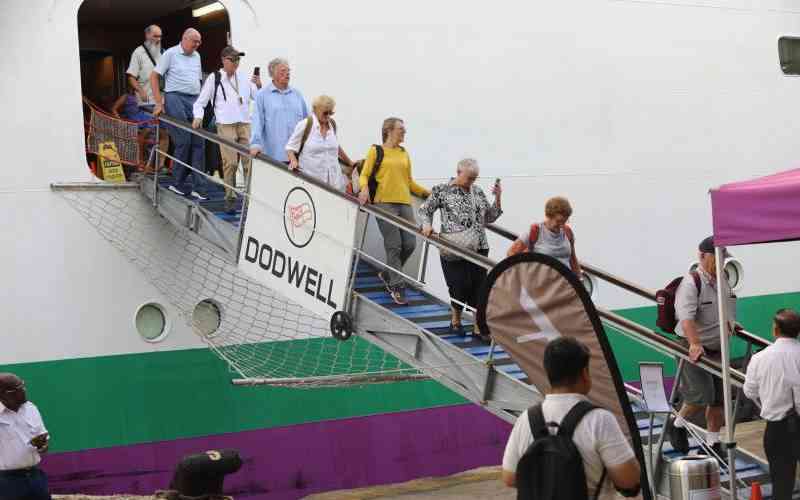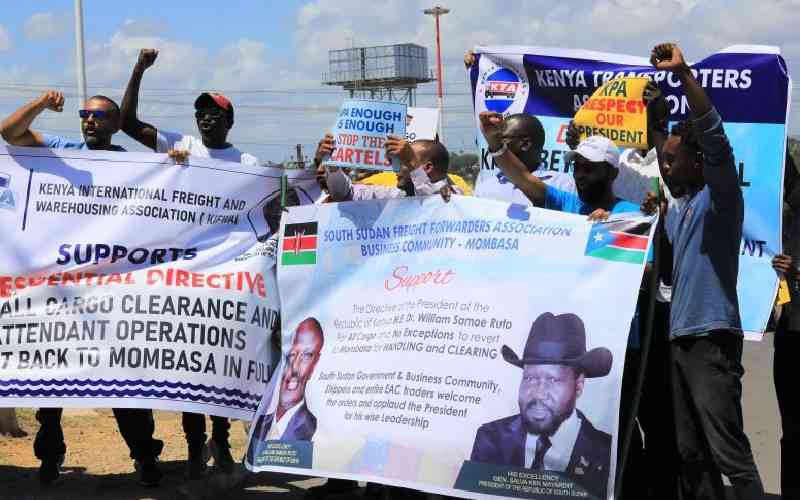By Amos Kareithi
When a group of five elders was dispatched in search of military assistance from Oman, little did they know they were providing the first blocks for a jigsaw puzzle that would take over three centuries to untangle.
After more than 350 years, echoes of the five Swahili delegates journey are still haunting Kenya, which is now threatened with cession as the descendants of the elders demand autonomy.
Ironically, when Mwinyi Nguti, Mwinyi Mole bin Hajji, Mwinyi Ndao bin Hajji, Moto Wa Mtorogo and Kubo Wa Mwamzungu set out for Muscat, they were motivated by a desire to ward off invasions by the Portuguese.
In yet another ironic twist, the elders’ request for assistance was rejected by the Sultan of Oman, although seven decades later in 1729, another delegation would retrace the journey and succeed in establishing military and political bonds that would shape the destiny of the East Coast of Africa.
Moi University historian John Mwavurie’s paper, The Ten Miles Coastal strip: An Examination of the Intricate Nature of Land Question at Kenyan Coast, believes this was the genesis of the Arab domination of the Coast.
Ultimately, the Arabs kicked the Portuguese out of Mombasa but delivered the East Coast of Africa to the Omani Arabs who would later annex and place it under the Sultan’s of Zanzibar. Previously, the Swahili had been residing in the 10-mile strip for centuries as they fished and traded with Arabs and other sailors from different parts of the world including China.
Ancient records
This narrative is backed by ancient records such as The Periplus of the Erythrean Sea dating back to 100 AD by anonymous authors, who describe the inhabitants of the region as black men of great stature that were ruled by chiefs.
“There is no doubt that the Swahili controlled the Coast before Arabs settled in the area. It would seem the conquest of the Coast by the Portuguese from 1,500 and their ruthless administration was the main cause for the Swahili to enter into a marriage of convenience with the Omani Arabs,” Mwavurie writes.
In a case of history repeating itself, the advance of Britain and Germany, which were trying to carve territories for themselves in Africa, threatened the Sultan of Zanzibar. After the scramble and sharing out of Africa, Germany and Britain worked out an arrangement and summarised the 1886 treaty where they both avoided conflict by determining their spheres of influence in East Africa. Since none of them wanted to start a war with Zanzibar, they decided to allocate the Sultan a 10-mile strip running from Kipini to the north and River Ruvuma in the south.
The Britain’s agreement with the Sultan of Zanzibar averted a conflict then but has been a source of conflict along the Coast of Kenya since it was penned on March 14, 1890. According to the agreement, Sultan Sayyid of Zanzibar surrendered all his authority over a people his ancestors had vowed to protect 161 year earlier.
This deal was sweetened by the promise of handsome payments. In exchange, the Sultan surrendered the coastal strip.
The agreement reads: “Highness the Sultan of Zanzibar and its East African dependences concede to the British East Africa by all the powers to which he is entitled on the main land lying between Kipini and also the Islands embraced in such territories including Manda, Faza and Banadir Coast up to Kismayu.”
Under this agreement, the Imperial British East Africa Company (IBEA) was supposed to pay the Sultan the gross revenue of the customs collected by them that was to be pegged on the experience of the first year. The Sultan had cushioned himself by including a clause that insulated him from being made to suffer should the company make any loses as the company was supposed to cushion him against such financial loses.
Stay informed. Subscribe to our newsletter
Secured deal
The Sultan and George Mackenzie, who at the time was the administrator in chief of IBEA, ratified it in Zanzibar. The Sultan secured a deal with the British Government where he would receive a payment of £17,000, (now Sh2,2m) some of which was an interest of £6,000 (Sh785,000) for the £200,000 (Sh26m)paid to IBEA for the company assets in the sultanates Zanzibar by 1895.
Earlier on June 20, 1887, the company had convinced three elders to surrender their sovereignty to Britain, without paying them a penny, marking a trend where other people at the Coast and in the interior would unwittingly give away their freedom.
In their treaty, Mbogoli, M’Taveta and Kamba were in agreement that they had placed their country and people under the company and that they would host the flag of Zanzibar as had been agreed between the Sultan and the IBEA. For the next 25 years, the British Government went about administering the coastal strip as per the agreement with Zanzibar, dutifully paying the agreed ‘rent” to the Sultan even as it taxed other parts of the protectorate to develop the coastal strip.
When Britain decided to declare Kenya a colony in 1920, the original agreement with the Sultan was amended again to suit the needs of the British that were aware of the international implications of annexing the territory.
Mwavurie explains that Britain went around this problem by renaming Kenya a colony and a protectorate, where the coastal strip was administered differently from other parts of the country.
This, however, bought the colonialists another 41 years before a major storm erupted in 1961 as they prepared to hand over the reins of power to the Africans who had to put up with repression since the 1890s.
As the country geared towards independence, Britain realised that the coastal strip, which had not been part of the Kenya colony was now presenting a headache as some of the residents feared that being lumped together in a patchwork of a new country would disadvantage them.
Some of the most vocal proponents of the autonomy of the coastal strip were 580 Europeans led by their association’s chairman, A Twelfetree who owed land in Likoni, Malindi, Kilifi and Kwale, who wanted an independent state to be established at the Coast.
Another group that wanted a free state was the Arabs, who were against being lumped together with Africans, who in their opinion could not lay any claim to the Coast as they had always lived away from the coastline. The Banjuni’s of Lamu and other outlying lands were also agitating for their own country, the Banjuni Land, comprising of approximately 30,000 residents while another section of 100 wanted to be adjoined to a country that would include parts of Somalia.
Gateway to East Africa
One teacher, Yahya Ali proposed to Sir James Robertson, who was chairing a committee collecting views on the future of the strip that Swahilini be formed with headquarters situated at Zanzibar. Robertson reminded Yahya and those calling for complete breakaway of the coastal strip from other parts of the colony that the Uganda Railway and the harbour were the gateway to East Africa and Tanganyika and Uganda would equally be affected.
At the time, the coastal strip did not have any reliable clean water and was dependent on Mzima Springs, which were more than 100 kilometres away from the Coast. After collecting views from the residents of the coastal strip, Robertson made some recommendations providing for Muslim Law and religion and Kadhi’s courts to be incorporated in the Constitution.
It was further resolved that the 1895 deal would be abrogated and the Sultan paid compensation of £675,000 (Sh88m) as compensation for forfeiting the coastal strip and a further £400,000 (52m) from the time Germany paid the Sultan £200,000 (26m). So as to win the confidence of the Arabs and other people owing land at the coastal strip, it was resolved that land titles be acknowledged and guaranteed.
After lengthy talks that at one time delayed and threatened to derail Kenya’s independence, the issue of coastal strip was resolved. However, 49 years after independence, just after Kenya’s second republic ushered after the promulgation of a new Constitution, the matter of the coastal strip and cession has emerged again.
There is little likelihood of another Lancaster Conference being conducted to resolve the issue, and neither is Zanzibar, which has since become part of Tanzania likely to attend any such talks.
As Mombasa Republican Council face off with the Government over the future of the strip, Tanzania, Uganda and other states that use the port of Mombasa will be watching the unfolding drama with keen interest.
But as Mwavureia warns, the old debate of who between the indigenous inhabitants of the strip and the Arabs are the original owners of the strip will resurface yet again and dominate any proceedings.
But the echoes of independence leaders Jomo Kenyatta, Ronald Ngala, Tom Mboya and Jaramogi Odinga as they vehemently opposed any attempts to alienate the coastal strip warning that any such move would be resisted.
[email protected]
 The Standard Group Plc is a
multi-media organization with investments in media platforms spanning newspaper
print operations, television, radio broadcasting, digital and online services. The
Standard Group is recognized as a leading multi-media house in Kenya with a key
influence in matters of national and international interest.
The Standard Group Plc is a
multi-media organization with investments in media platforms spanning newspaper
print operations, television, radio broadcasting, digital and online services. The
Standard Group is recognized as a leading multi-media house in Kenya with a key
influence in matters of national and international interest.
 The Standard Group Plc is a
multi-media organization with investments in media platforms spanning newspaper
print operations, television, radio broadcasting, digital and online services. The
Standard Group is recognized as a leading multi-media house in Kenya with a key
influence in matters of national and international interest.
The Standard Group Plc is a
multi-media organization with investments in media platforms spanning newspaper
print operations, television, radio broadcasting, digital and online services. The
Standard Group is recognized as a leading multi-media house in Kenya with a key
influence in matters of national and international interest.








